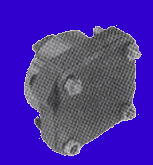|
| |


Take
a look at an oil pump, it consists of two gears and a case, not much to it. The
oil is picked up from the centre of the engine (above the oil draining plug) and
enters the pump on the right, leaves on the left and heads for the first
pressure relief valve (the one below and to the left of the pump), if the oil is
hot it is sent to the oil cooler, if not it goes straight to the bearings via
the oil pressure switch. Once here it feeds the camshaft, the cam followers
(which in turn feed the rocker shaft through the pushrods), the crankshaft and
the big end bearings and then the small end bearings. The last part of its
journey is through the second pressure relief valve (this is near the flywheel
end), this keeps the oil pressure to its set value.
You can replace the relief valves and springs with higher pressure versions,
these aren't really worth the effort, as the standard version works well,
although new springs wouldn't hurt. These are often just a longer piston rather
than a longer spring, but sometimes you get both. The spring/valve nearest the
oil pump is the oil cooler bypass and will open when the oil is thick and cold
to prevent the cooler from blowing out. If this valve jams open you will not get
your oil properly cooled, or if the valve remain closed you might blow the
cooler out the next time you run fresh oil on a cold day. The front spring/valve
(nearest the flywheel) is to retain a minimum oil pressure. You can replace the
oil pump with a higher pressure version, these are the same design except have
larger gears in a larger case. This guy would not ever run a high pressure oil
pump with oil pressure boost springs.
There are oil pump covers available with an outlet pipe, which is to allow an
oil filter to be added. You will have to block the pumps normal outlet by
pushing a bung into the hole in the case (you should tap the case and use a
length of thread with a screw slot in so it can be removed later, if need be),
then drill a hole in the case (you can see the raised part of the case that goes
up and to the left at 45 degrees from the pump, follow that up until it comes to
a lug in the case facing toward you and use that as your return point) tap this
to 1/4 BSP (this is the standard thread type used in oil systems) and connect
your filter. Use externally braided hose, as being so close to the ground and
near so many other parts it will need protecting from damage. Do not fit your
filter where it can be damaged i.e. inside the wheel arch or too near the
ground. DO NOT FIT AN OIL COOLER ON THIS PIPE.
There are also dry sump pumps, these are a two stage pump, the first is the oil
in, this takes oil from a separate tank and pressurizes it into the engine. The
second stage is the oil recovery which is twice the size of the first and sucks
the oil up from the bottom of the engine and returns it to the tank. They are
not all that common on road cars, their main use is when an engine is pushed
from side to side a lot, such as off road. When using an engine in this way the
oil spends a lot of time being pushed into the heads and therefore not near the
oil pickup, so seizure is waiting to happen. These pumps are expensive, they
require an extra tank, a lot more hose and some case machining. Don't bother
with one for the road, you don't need it. This guy used one for hill climbing as
without one I could not have gone around the bends quite as fast.
There are sump baffles, these work quite well. They are a simple drilled plate
that slips into the case just below the camshaft. The idea is to prevent the oil
easily running into the cylinder heads on cornering and starving the oil pickup.
this guy has used and is happy with an oil suction kit, this consists of a new
sump plate with an extension to the oil pickup that fits very close to it. The
idea being, it only requires about 4mm of oil to still be able to pick it up,
the standard pickup requires about 10mm.
You could consider a high capacity oil sump, these add about 1.2 pints (0.7 ltrs)
of oil to the engine. They come with an extension to fit onto the standard
pickup which collects the oil from the new tank. They have one major
disadvantage, they hang about 3 inches (75mm) below the engine and can cause a
problem with a lowered car. The idea here is that they do not give you any
cooler oil, but it does take longer to heat and you have more supply when
cornering and therefore less chance of seizure.
Mini sumps work like a mixture of the last two sumps, they have an extra mini
sump along with an extension pickup. I still prefer the oil suction kit.
Coolers: There are many different kits available for cooling your oil. If your
engine's oil regularly rises above 120 degrees C you need an external cooler.
These use an adaptor that fits in place of the standard cooler and has two
connecting pipes on, one in and one out, which point towards the flywheel. Some
kits come with fitting instructions that show the cooler fitted to the fan
housing inlet, whoever thought of this should also be strapped to the fan intake
themselves. The air going into the fan housing should be as cold as possible,
warming it up with an oil cooler is rather defeating the object. Fit your oil
cooler somewhere under the car, along side the gearbox or somewhere where it is
out of the way of any passing objects, but close enough to the fresh air.
Don't run an oil cooler from an oil pump outlet plate (as mention
earlier) as this will send cold oil to the cooler when you start your engine in
the morning which will cause extra stress on the cooler and could blow it out.
That's what the first pressure relief if for, it only sends oil to the cooler if
it's hot. That is why this guy cannot understand the shops selling uprated rear
(cooler bypass) relief springs and pistons.
|




![]()